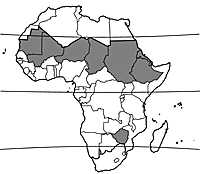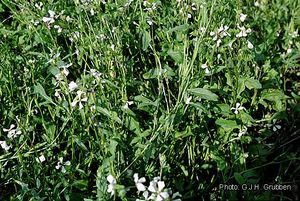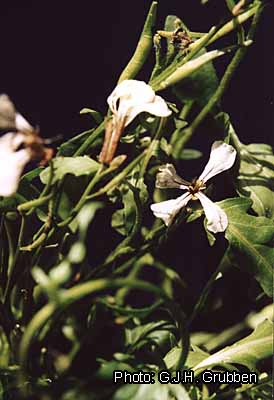Eruca vesicaria (PROTA)
Introduction |
| General importance | |
| Geographic coverage Africa | |
| Geographic coverage World | |
| Vegetable | |
| Vegetable oil | |
| Medicinal | |
| Forage / feed | |
| Food security | |
Eruca vesicaria (L.) Cav.
- Protologue: Descr. pl.: 426 (1802).
- Family: Brassicaceae (Cruciferae)
- Chromosome number: 2n = 22
Synonyms
- Eruca sativa Mill. (1768).
Vernacular names
- Garden rocket, rocket salad, rucola, arugula (En).
- Roquette (Fr).
- Eruca, rúcola (Po).
Origin and geographic distribution
Eruca vesicaria originated in the Mediterranean region and western Asia extending as far as Afghanistan, where it is still a fairly common wild plant. Its distribution is expanding through escapes from cultivation and it can now be found as an occasional weed in western and central Europe, western and central Asia, North America and Australia, and also in tropical Africa (e.g. Ethiopia, Zimbabwe) and South Africa. Cultivation probably started in northern Africa and the eastern Mediterranean region and later extended into the Sahel region. A second region where the cultivation of garden rocket has a long history extends from western and central Asia to northern India. Currently, garden rocket is cultivated all around the world, but remains most important in the Mediterranean region. In Africa it is grown throughout the Sahel region, from Mauritania in the west to Ethiopia and Eritrea in the east. It is especially popular in Sudan.
Uses
Garden rocket is an ancient crop revered by the ancient Greeks, who used both the seed oil and the leaves for their alleged aphrodisiac properties. It is also an ancient crop in Afghanistan, Pakistan and northern India where it is primarily grown for its oil called ‘jamba oil’ or ‘taramira oil’. In the Mediterranean region it developed into a salad vegetable. The taste of the leaves resembles that of watercress, being similarly sharp with a mustard-like pungency. Young, fresh leaves that are not too pungent are becoming increasingly popular in western cuisine and are consumed raw in green salads. They are often added steamed or raw to Italian dishes and pizzas. In Arab countries pieces of meat served with rocket leaves form a popular dish; these leaves, locally called ‘gargeer’, are generally more mature and therefore sharper than the ones eaten in salads in Europe. Older leaves and seeds are used as a condiment and mature leaves can be cooked or utilized in sauces. Another vegetable use is as ‘rocket sprouts’, whereby the young seedlings are cut when the cotyledons are fully opened or when the first pair of true leaves is present. In Africa garden rocket is used as a vegetable, a condiment and as an oil crop.
Garden rocket is used as a medicinal plant against eye infections and to treat digestive and kidney problems. It is considered an excellent stomachic and stimulant, and is also used as a diuretic and antiscorbutic. The leaves are used as a rubefacient on the skin. Garden rocket has always been considered a potent aphrodisiac and people in the Mediterranean region still use it as such. Its oil can be used for massage and for soothing the skin. Garden rocket can cause burning reactions.
The seed oil has a high erucic acid content and is used as an industrial oil for lubrication and illumination. The seeds are also used to produce a kind of mustard. Taramira oil and jamba oil are still used in India for pickling. Its use as a salad or cooking oil is limited because of its initial acridity; the acridity disappears after storage for 6 months and the oil can then be used for cooking purposes. The leaves and crop residues are fed to camels, cattle and sheep, and the cake remaining after oil extraction is also used to feed livestock.
Production and international trade
Garden rocket is popular in the Mediterranean region and Sudan, and in Sudan alone there is about 3000 ha of year-round cultivation under irrigation, mainly for the leaves. No statistics on growing areas are available for other Sahel countries. Garden rocket is traded in local markets throughout northern Africa. It is becoming increasingly important as a salad crop in western Europe and the United States, but statistics on production are not available.
Properties
The composition of fresh garden rocket leaves per 100 g edible portion is: water 91.8 g, energy 88 kJ (21 kcal), protein 2.7 g, fat 0.2 g, carbohydrate 3.7 g, fibre 0.9 g, Ca 352 mg, P 46 mg, Fe 0.8 mg (Leung, W.-T.W., Busson, F. & Jardin, C., 1968). The vitamin A content is 4770 IU.
The leaves contain glucosinolates, of which 4-mercaptobutyl glucosinolate is the most important; 4-methylthiobutyl glucosinolate and 4-methylsulfinylbutyl glucosinolate are present at lower concentrations. These compounds contribute to the unique odour and flavour of garden rocket. Glucosinolates are becoming increasingly important as flavour precursors, cancer prevention agents and crop protectants.
The seed oil is rich in erucic acid and gadoleic acid, containing 33–45% and 7.3–9.8%, respectively. The seeds also contain glucosinolates. Tests showed amelioration of alloxan-induced diabetes mellitus and oxidative stress in rats by daily oral administration of the seed oil.
Adulterations and substitutes
As a spicy vegetable, garden rocket can be replaced by watercress (Nasturtium officinale R.Br.), radish (Raphanus sativus L.) and to a lesser extent by leaf mustard (Brassica juncea (L.) Czern.) and white mustard (Sinapis alba L.). In North Africa and Europe, it is frequently replaced by other species that are also called rocket and especially by Diplotaxis tenuifolia (L.) DC., which is generally milder in taste. As an oil seed or mustard crop it can be replaced by several Brassica species.
Description
- Erect annual herb up to 80(–100) cm tall, branched; stem glabrous or sparsely covered with rough hairs.
- Leaves alternate, petiolate (upper ones almost sessile), lyrate-pinnatifid, up to 12 cm × 4 cm, irregularly serrate.
- Inflorescence a terminal raceme without bracts.
- Flowers bisexual, regular, 4-merous; sepals free, erect, c. 1 cm long; petals free, spatulate, distinctly clawed, up to 2 cm × 1 cm, white to pale yellow or pale violet with violet veins; stamens 6, free; ovary superior, elongate, 2-celled, style simple.
- Fruit an ellipsoid silique up to 4 cm long, with a distinct, flat beak, longitudinally dehiscent, many-seeded.
- Seeds 1.5–2.5 mm long, smooth, brownish.
Other botanical information
Eruca comprises about 5 species and is native to the Mediterranean region and western Asia. Two subspecies of Eruca vesicaria are distinguished: subsp. vesicaria with persistent sepals all pouched, and subsp. sativa (Mill.) Thell. with caducous sepals of which only the outer two are pouched. The latter is often considered to represent a distinct species: Eruca sativa Mill. The leafy vegetable belongs to subsp. sativa.
Growth and development
Germination takes about 1 day at 25°C, 2–3 days at lower temperatures. The first harvest of rosette leaves may start 3–4 weeks after germination. Garden rocket may produce flowers as early as one month after planting and seeds can be collected soon thereafter. Types grown specifically for their leaves usually flower about three weeks later than those grown for their oil seeds.
Ecology
Garden rocket grows spontaneously in disturbed localities including abandoned gardens and roadsides. It prefers a hot, dry climate and full sun. It is a hardy plant, which requires little care. Under favourable climatic conditions it can be grown on almost any type of soil, but it prefers sandy and sandy-loam soils. Garden rocket tolerates salt reasonably well.
Propagation and planting
The seeds are sown on raised beds in shallow furrows spaced at 15–22 cm or seeds are broadcast directly in the field. A density of 100 plants/m2 was found to give the highest yield, but in Italy densities of up to 300 plants/m2 are used. The seed requirement is about 20 kg/ha for row planting and 50–80 kg/ha when broadcast. For oil production, wider spacings and correspondingly lower seed rates are used. In the subtropics sowing takes place in late winter or early spring, during cool but mild weather in moist, fertile soil. To encourage emergence, the seed is covered with 1–3 cm of light, sieved soil.
Management
Although garden rocket is fairly tolerant of salt, the high salt level often found in the top layers of desert soils has a negative impact on germination and further growth. Some farmers therefore first irrigate their land to leach out excessive salts from the top soil. Subsequently irrigation should be applied regularly at short intervals of 3–4 days. Once established, garden rocket requires little irrigation. Because of the fast early growth only light weeding is needed. It is recommended that organic manure be used at a rate of 25–50 t/ha during land preparation and that urea be added at a rate of 100 kg/ha 3 weeks after planting. Nitrogen fertilizing and shading result in more tender leaves with a milder taste. Fertilizer recommendations for garden rocket grown as an oil crop are lower.
Diseases and pests
Garden rocket is very susceptible to clubroot (Plasmodiophora brassicae). Powdery mildew (Erysiphe cichoracearum) is one of the few other diseases that affect garden rocket. Flea beetles (Phyllotreta cruciferae) often gnaw small holes in the foliage and it is therefore important to observe a proper crop rotation. Other pests affecting garden rocket are thrips (Caliothrips spp.) and jassids (Empoasca lybica).
Harvesting
Harvesting starts 3–6 weeks after sowing, when young, tender leaves and shoots are picked. The bottom set of leaves should be left to allow new shoots to regenerate. If cut too low the plant is killed. A total of 2–3 cuts are usually made before the plant starts flowering and no further leaf harvests are possible. Farmers usually leave their plants in the field to produce seed for the next season’s crop.
Yield
A good yield of leaves is 12–16 t/ha, most of which is collected from the first harvest. In India seed yields range from 350–1000 kg/ha.
Handling after harvest
Leaves can be stored in plastic boxes for 2–3 days at 0°C.
Genetic resources
Many landraces exist, allowing ample scope for selection. The largest collections of Eruca germplasm are maintained at the Institute of Germplasm in Bari, Italy, at NBPGR, New Delhi and Haryana Agricultural University in India, and at the N.I. Vavilov All-Russian Scientific Research Institute of Plant Industry in Petersburg, Russia. In 1985, 25 samples of germplasm of Eruca vesicaria were collected in north-eastern Sudan.
Breeding
A wide variability has been observed with regard to erucic acid and glucosinolate contents. However, the development of cultivars with a low glucosinolate content does not appear to be an improvement objective since it would diminish the characteristic flavour. Attempts have been made to use Eruca vesicaria as a genetic resource for improving other crucifers. In this way, intergeneric hybrids have been obtained with Raphanus sativus L., Brassica rapa L. and Brassica oleracea L. Somatic hybrids have been obtained through the fusion of protoplasts with Brassica napus L. and Brassica juncea (L.) Czern. There are types of garden rocket which are resistant to mustard aphid and can tolerate several sorts of stress conditions as well as Fusarium oxysporum.
Prospects
Garden rocket is a nutritious vegetable and although not everybody appreciates its characteristic pungent flavour, more attention should be given to its production and improvement. Sufficient genetic variation exists to be able to modify its taste. It also deserves further testing as an oil seed crop for Sahel countries and other drought-prone regions since it tolerates low rainfall conditions.
Major references
- Andrews, F.W., 1950. The flowering plants of the Anglo-Egyptian Sudan. Volume 1. Buncle, Arbroath, United Kingdom. 237 pp.
- Broun, A.F. & Massey, R.E., 1929. Flora of the Sudan. Thomas Murby, London, United Kingdom. 502 pp.
- Burkill, H.M., 1994. The useful plants of West Tropical Africa. 2nd Edition. Volume 2, Families E–I. Royal Botanic Gardens, Kew, Richmond, United Kingdom. 636 pp.
- Jonsell, B., 2000. Brassicaceae (Cruciferae). In: Edwards, S., Mesfin Tadesse, Demissew Sebsebe & Hedberg, I. (Editors). Flora of Ethiopia and Eritrea. Volume 2, part 1. Magnoliaceae to Flacourtiaceae. The National Herbarium, Addis Ababa University, Addis Ababa, Ethiopia and Department of Systematic Botany, Uppsala University, Uppsala, Sweden. pp. 121–154.
- Nuez, F. & Hernández Bermejo, J.E., 1994. Neglected horticultural crops. In: Hernández Bermejo, J.E. & León, J. (Editors). Neglected crops: 1492 from a different perspective. Plant Production and Protection Series No 26. FAO, Rome, Italy. pp. 303–332.
- Padulosi, S. & Pignone, D. (Editors), 1996. Rocket: a Mediterranean crop for the world. [Internet] IPGRI workshop report, 13–14 December 1996, Padova, Italy. 97 pp. http://www.ipgri.cgiar.org/publications/pdf/234.pdf. 12 November 2003.
- Schippers, R.R., 2002. African indigenous vegetables, an overview of the cultivated species 2002. Revised edition on CD-ROM. National Resources International Limited, Aylesford, United Kingdom.
- Yaniv, Z., Schafferman, D. & Amar, Z., 1998. Tradition, uses and biodiversity of rocket (Eruca sativa, Brassicaceae) in Israel. Economic Botany 52(4): 394–400.
Other references
- Bennett, R.N., Mellon, F.A., Botting, N.P., Eagles, J., Rosa, E.A. & Williamson, G., 2002. Identification of the major glucosinolate (4-mercaptobutyl glucosinolate) in leaves of Eruca sativa L. (salad rocket). Phytochemistry 61(1): 25–30.
- Bennett, R.N., Mellon, F.A., Botting, N.P., Eagles, J., Rosa, E.A. & Williamson, G., 2002. Identification of the major glucosinolate (4-mercaptobutyl glucosinolate) in leaves of Eruca sativa L. (salad rocket). Phytochemistry 61(1): 25–30.
- Edwards, S.B., 1991. Crops with wild relatives found in Ethiopia. In: Engels, J.M.M., Hawkes, J.G. & Melaku-Worede (Editors). Plant Genetic Resources of Ethiopia. Cambridge University Press, Cambridge, United Kingdom. pp. 42–74.
- El Missiry, M.A. & El Gindy, A.M., 2000. Amelioration of alloxan induced diabetes mellitus and oxidative stress in rats by oil of Eruca sativa seeds. Annals of Nutrition and Metabolism 44(3): 97–100.
- Exell, A.W., 1960. Cruciferae. In: Exell, A.W. & Wild, H. (Editors). Flora Zambesiaca. Volume 1, part 1. Crown Agents for Oversea Governments and Administrations, London, United Kingdom. pp. 182–194.
- Jansen, P.C.M., 1999. Minor species. In: de Guzman, C.C. & Siemonsma, J.S. (Editors). Plant Resources of South-East Asia No 13. Spices. Backhuys Publishers, Leiden, Netherlands. pp. 244–272.
- Leung, W.-T.W., Busson, F. & Jardin, C., 1968. Food composition table for use in Africa. FAO, Rome, Italy. 306 pp.
- Marais, W., 1970. Cruciferae. In: Codd, L.E., de Winter, B., Killick, D.J.B. & Rycroft, H.B. (Editors). Flora of southern Africa. Volume 13. Botanical Research Institute, Department of Agricultural Technical Services, Pretoria, South Africa. pp. 1–118.
- Rich, C.G., 1991. Crucifers of Great Britain and Ireland. Handbook No 6. Botanical Society of the British Islands, Kirkby Stephen, United Kingdom. 336 pp.
- Zeven, A.C. & Zhukovsky, P.M., 1975. Dictionary of cultivated plants and their centres of diversity. Pudoc, Wageningen, Netherlands. 219 pp.
Sources of illustration
- Gómez-Campo, C., 1993. Eruca Mill. Flora Iberica. Volume IV: Cruciferae-Monotropaceae. Real Jardín Botánico, Madrid, Spain. pp. 390–392.
- Coste, H., 1901. Flore descriptive et illustrée de la France. Tome premier. Librairie des Sciences Naturelles, Paris, France. 416 pp.
Author(s)
- H.S. Ibn Oaf, Department of Horticulture, Faculty of Agricultural Sciences, University of Gezira, P.O. Box 20, Wad Medani, Sudan
Correct citation of this article
Ibn Oaf, H.S., 2004. Eruca vesicaria (L.) Cav. [Internet] Record from PROTA4U. Grubben, G.J.H. & Denton, O.A. (Editors). PROTA (Plant Resources of Tropical Africa / Ressources végétales de l’Afrique tropicale), Wageningen, Netherlands.
Accessed 19 December 2024.





